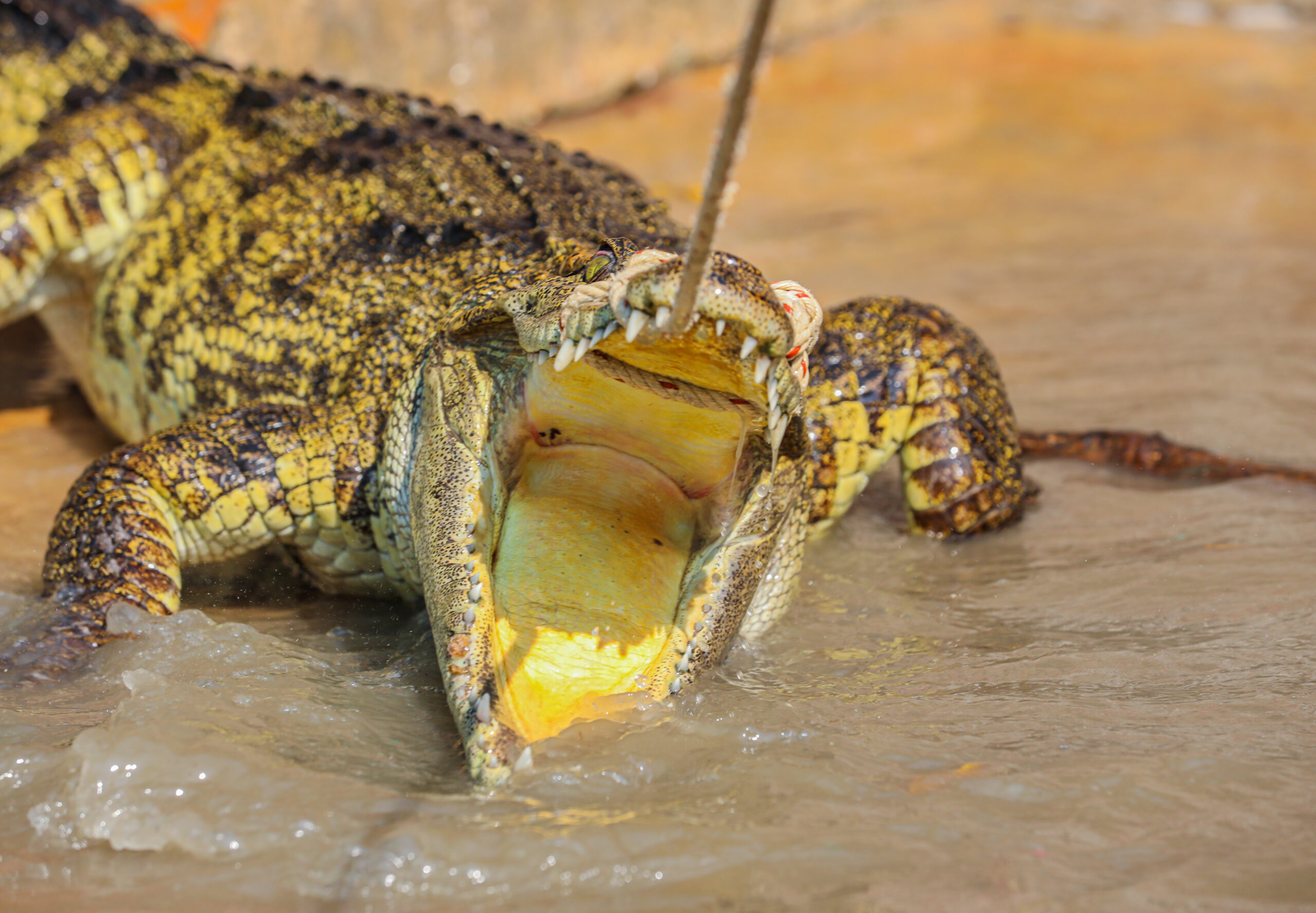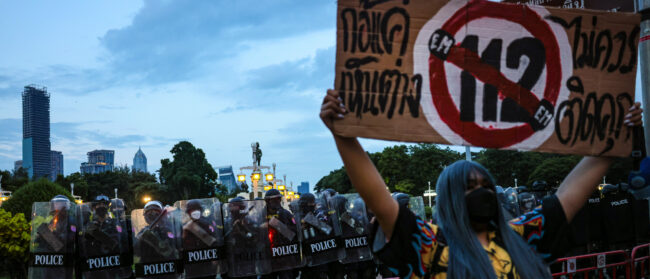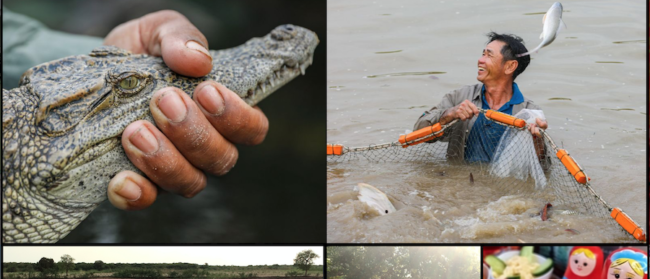A crocodile bellows as a rope is hooked around its teeth and yanked. The reptile rolls to evade capture, but is heaved from a concrete pool onto sun-cooked pavement. A wrangler steps on its snout to bind its jaw shut, turning the crocodile’s bellows to hisses.
Within an hour, more than 20 crocodiles are tied and piled into the bed of a truck. The crocodiles are some of more than 2,500 at a farm in Siem Reap. Buyers mainly in China, Thailand and Vietnam import live crocodiles from Cambodia to create leather products and other crocodile commodities.
The two dozen captured crocodiles, however, are not destined for sale or slaughter. Instead, the crocodiles are a donation from the farmer to conservationists trying to save Cambodia’s last wild populations of Siamese crocodiles.
“Until recently there wasn’t much of a relationship between farmers and conservationists,” said Joe Rose, captive breeding officer with Fauna & Flora International in Cambodia. “In the last year or so, we managed to meet a few open-minded farmers interested in conservation.”
Cambodia’s commercial crocodile farming industry relied on wild animals, to the point that the Siamese crocodile was believed to be extinct in Cambodia. Until 2000, when a Fauna & Flora survey rediscovered a remnant population in the Cardamom Mountains of southwestern Cambodia.
Only a few hundred Siamese crocodiles are estimated to survive in the wild in Southeast Asia. The Kingdom is home to the region’s largest wild population, which a 2015 study numbers between 200 to 400 individuals. Meanwhile, a regional report the following year estimated around 2,800 farms in Cambodia, Thailand and Vietnam house more than 1.53 million pure-bred and hybrid crocodiles.
The International Union for Conservation of Nature (IUCN) has classified the Siamese crocodile as ‘critically endangered’ on its Red List of Threatened Species since 1996. Despite being historically abundant in wetlands across mainland Southeast Asia through to Borneo and Java, Siamese crocodiles were extinct across most of its range by the 1990s.
An IUCN action plan called the species “one of the world’s most endangered crocodilians,” and a 2012 assessment estimated the species’ global population to number no more than 1,000 crocodiles in isolated populations across Cambodia, Laos, Indonesia, Thailand and Vietnam.
Hunting of wild populations for their skins was a main driver behind huge declines in the mid-20th century, compounded by a boom of crocodile farms in Indochina.
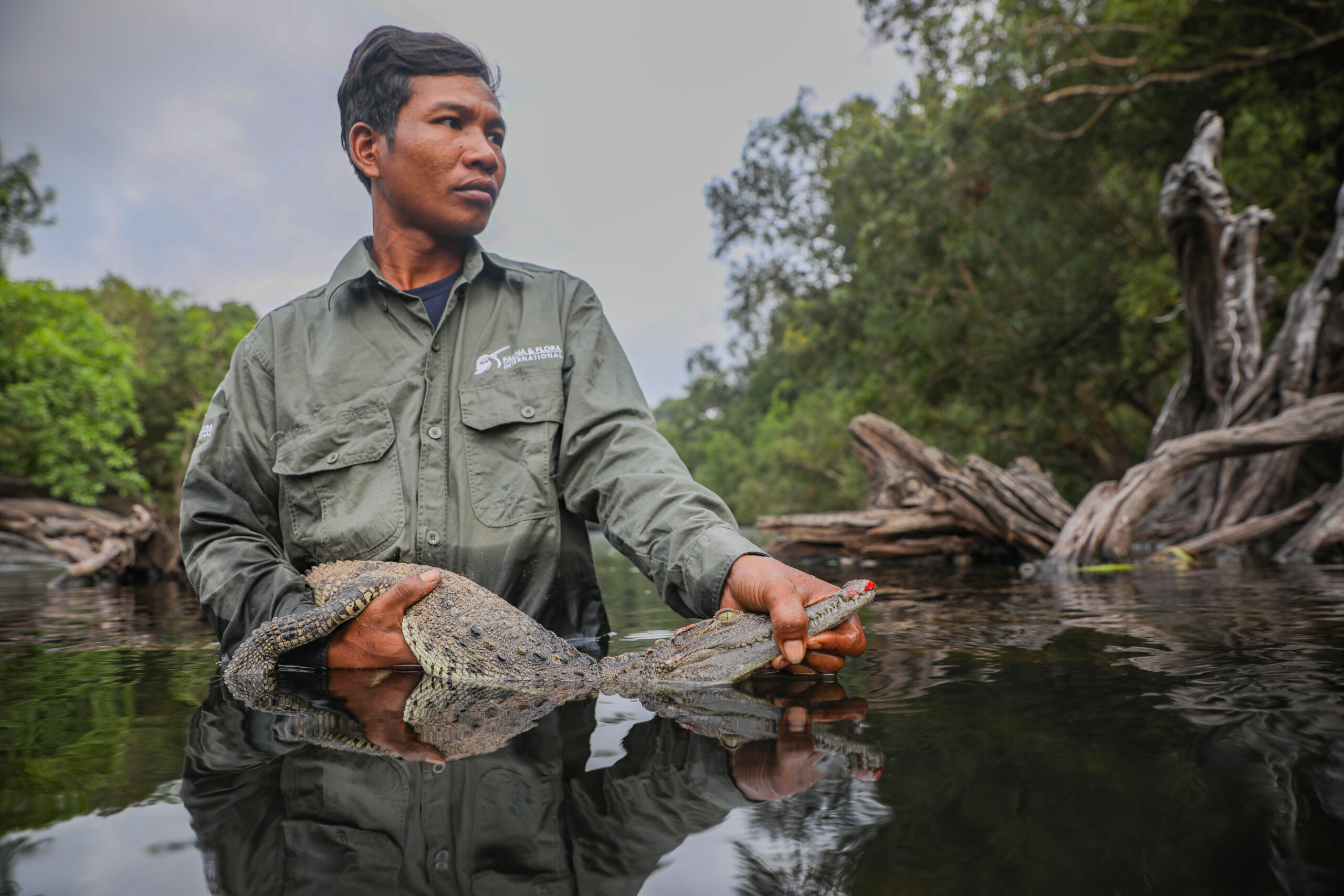
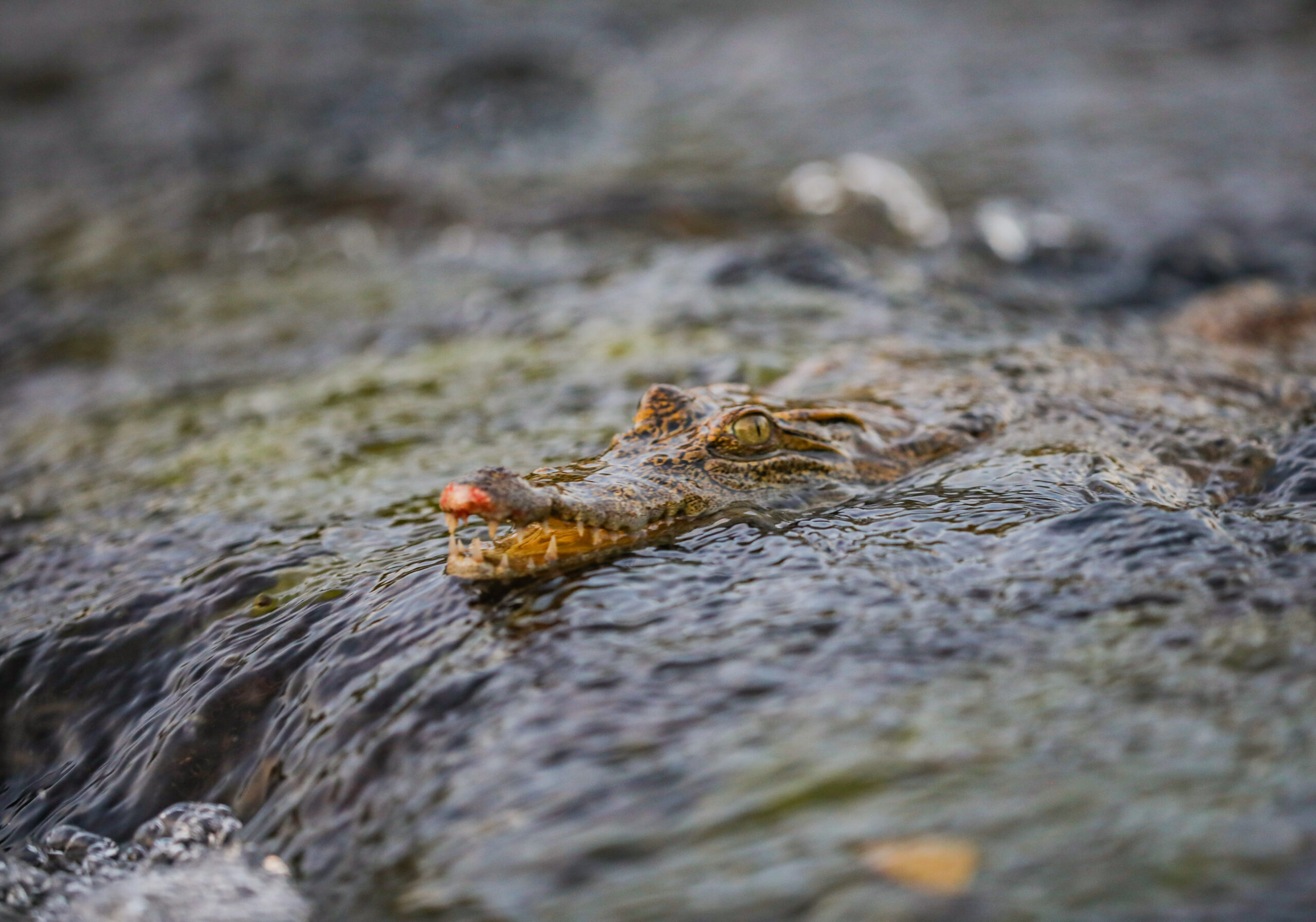
Cambodia’s first commercial crocodile farms, where wild-caught animals were kept and bred for their body parts, were established in the 1940s. The first farms in Thailand were recorded five years later, according to an IUCN Crocodile Specialist Group report.
“Wild populations got absolutely demolished because of farmers capturing crocodiles in the wild to build up their own stock,” Rose said, elaborating that this was common in Cambodia during the 1980s and 1990s as the industry grew.
By 2016, approximately 900 farms in Cambodia were estimated to have a stock of more than 250,000 crocodiles, including Siamese, Cuban and saltwater species and hybrids, according to a regional report on crocodile harvesting. Since farmers often purposefully interbreed species for commercial purposes, studies are frequently unable to determine how many pure-bred Siamese crocodiles are being farmed.
Beyond Cambodia, Siamese crocodile commercial farming occurs in Thailand and Vietnam, which the report estimates has 800 and 1,100 crocodile farms, respectively.
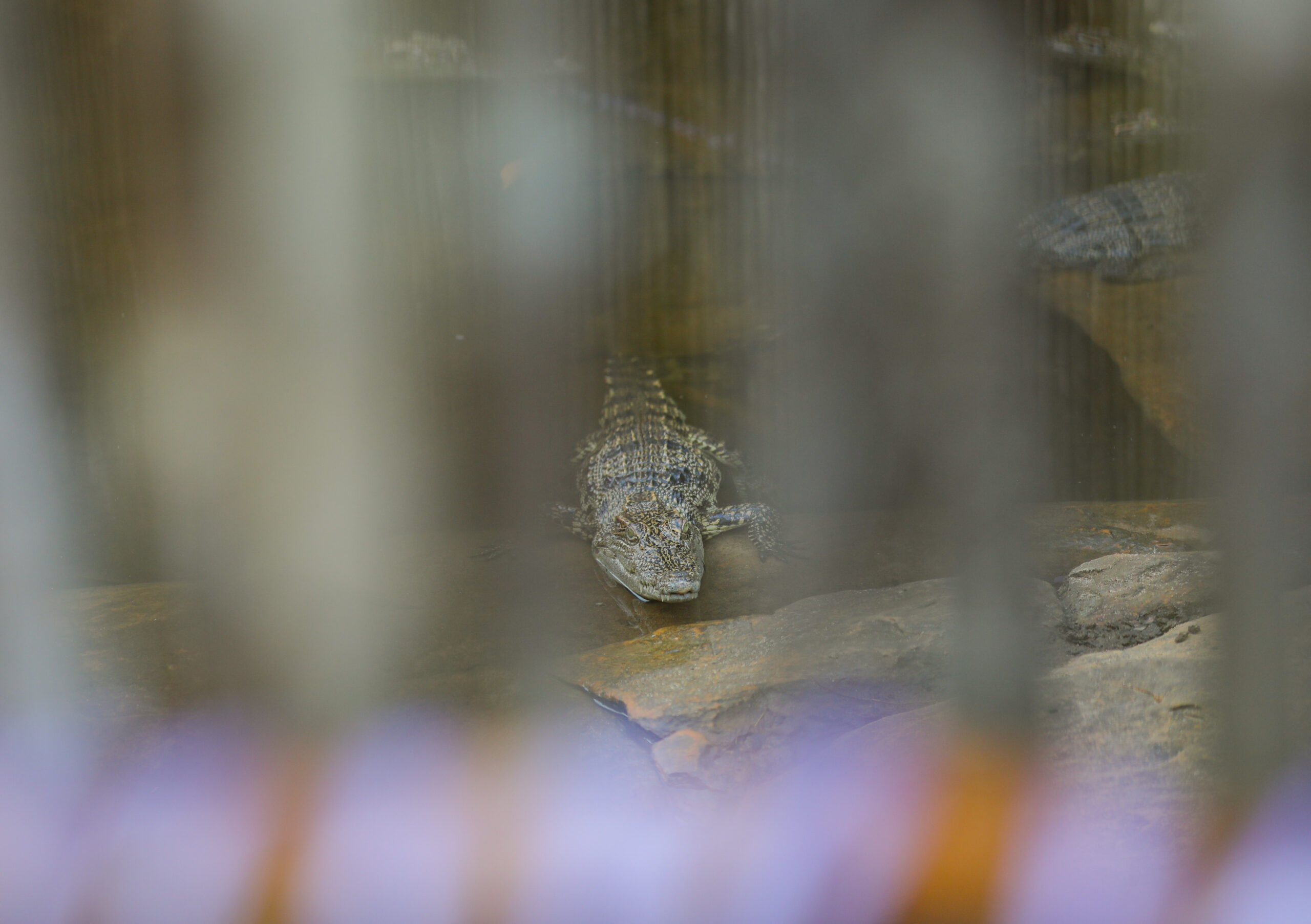
Cambodia’s 2006 Law on Fisheries prohibits activities such as habitat destruction and the unpermitted take of certain “aquatic animals,” according to an unofficial English-translation of the legislation. Penalties for fishery offences range from imprisonment of one month to five years and fines up to several million Cambodian riel. A following sub-decree lists Siamese crocodiles as one of the protected species, which also include the endangered Irrawaddy dolphin and critically endangered Mekong giant catfish.
Internationally, Siamese crocodiles (crocodylus siamensis) are protected through an Appendix I listing by the Convention on International Trade in Endangered Species of Wild Fauna and Flora (CITES). The international commercial trade of Appendix I species is generally prohibited, but there are exceptions.
As of April 2022, the list of CITES-registered captive-breeding operations, permitted to raise and export Siamese crocodiles, included 28 in Thailand, 21 in Cambodia and 10 in Vietnam. Singapore and the Philippines are the region’s only other countries with registered crocodile captive-breeding operations, with four facilities that breed saltwater crocodiles.
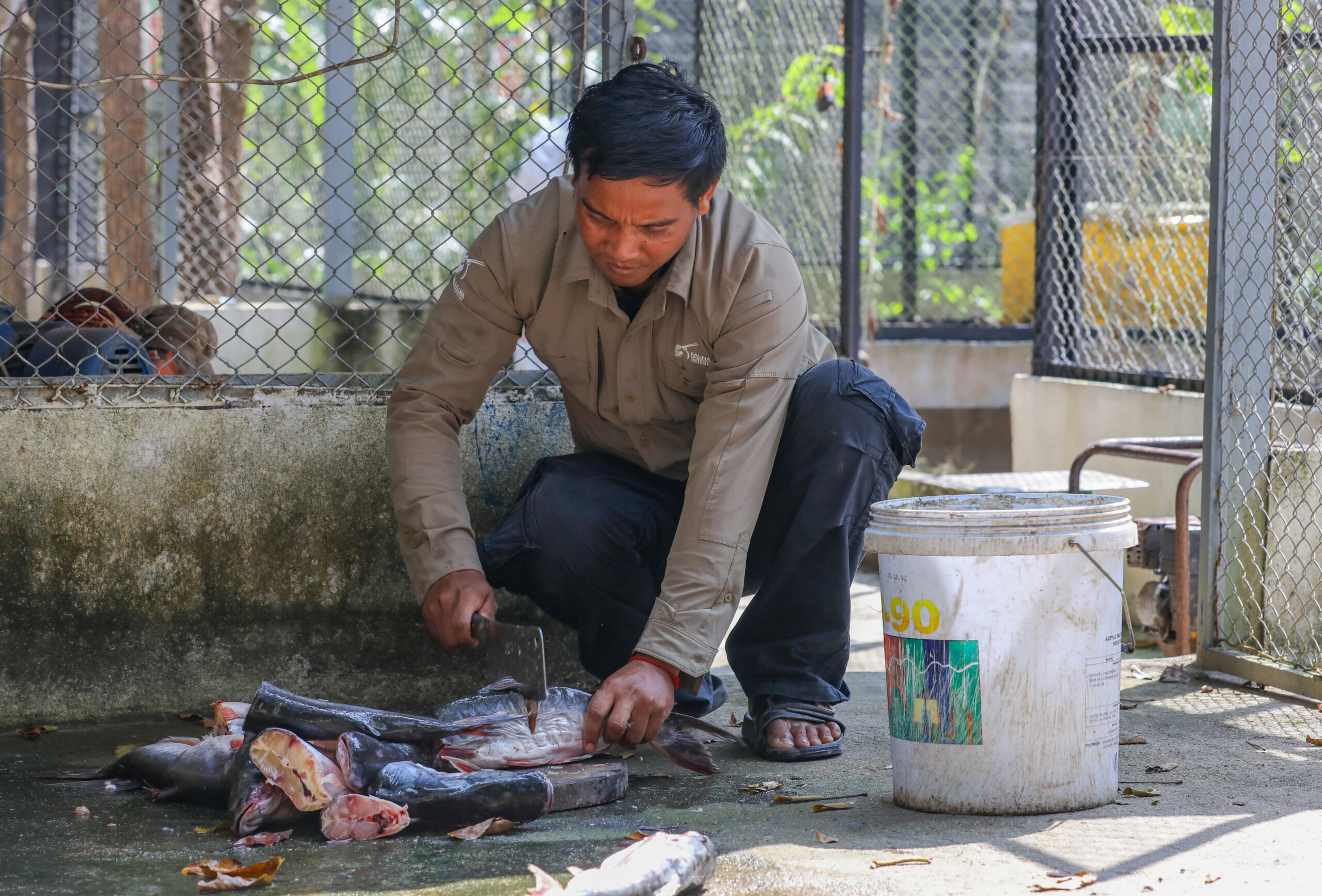
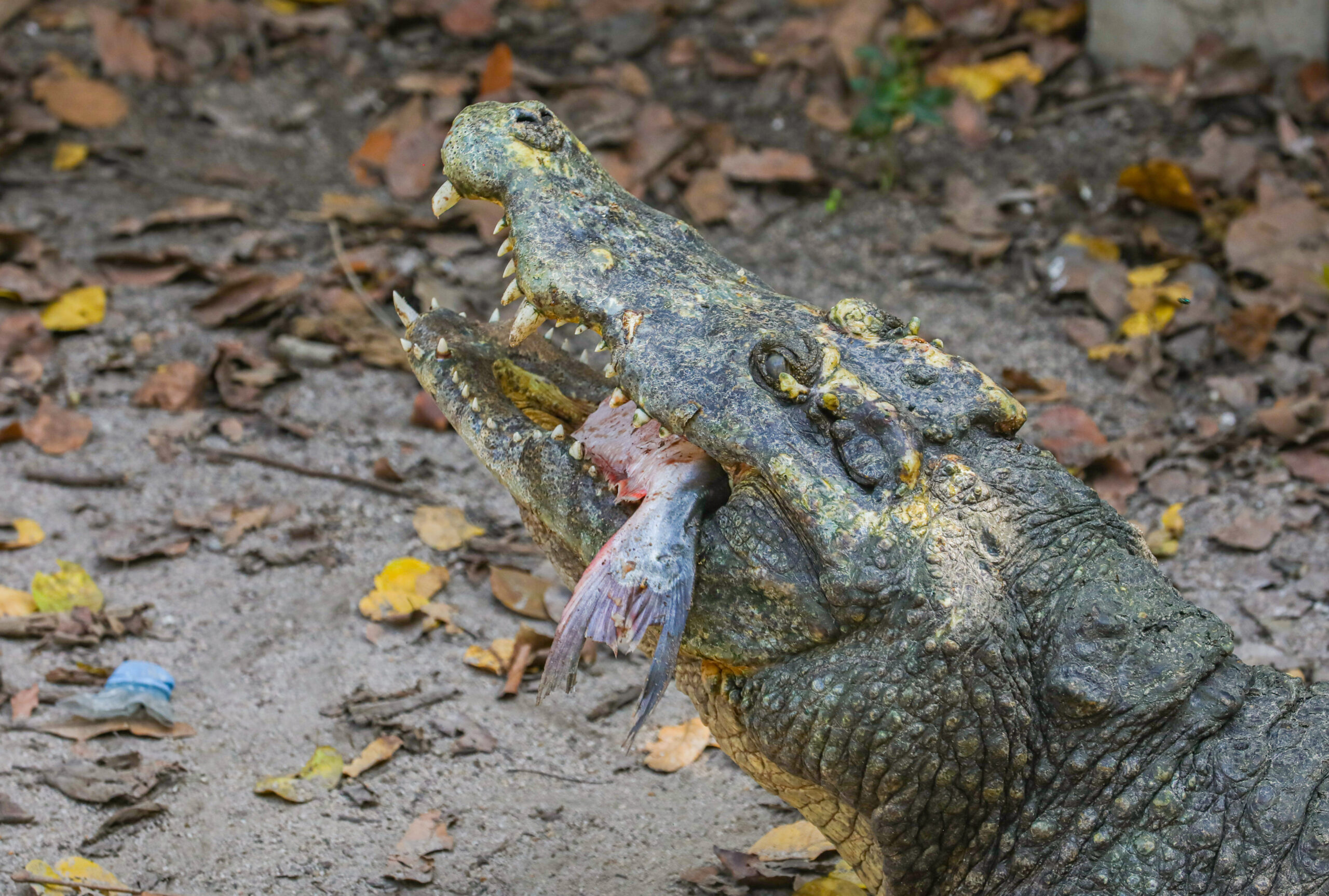
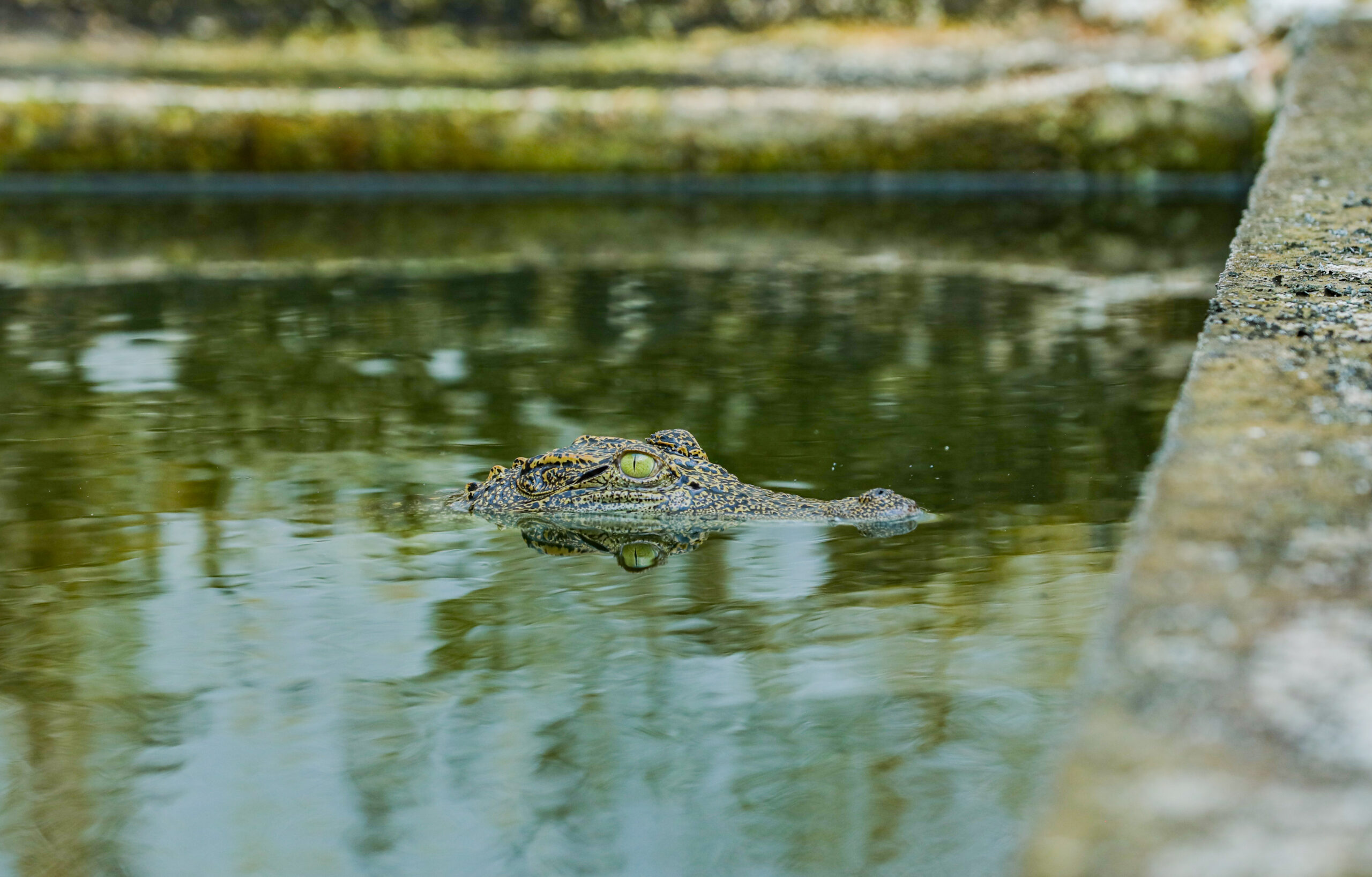
The Siamese Crocodile Breeding Facility in Phnom Tamao Wildlife Rescue Center is home to 137 critically endangered Siamese crocodiles, from hatchlings and yearlings to juveniles and adults.
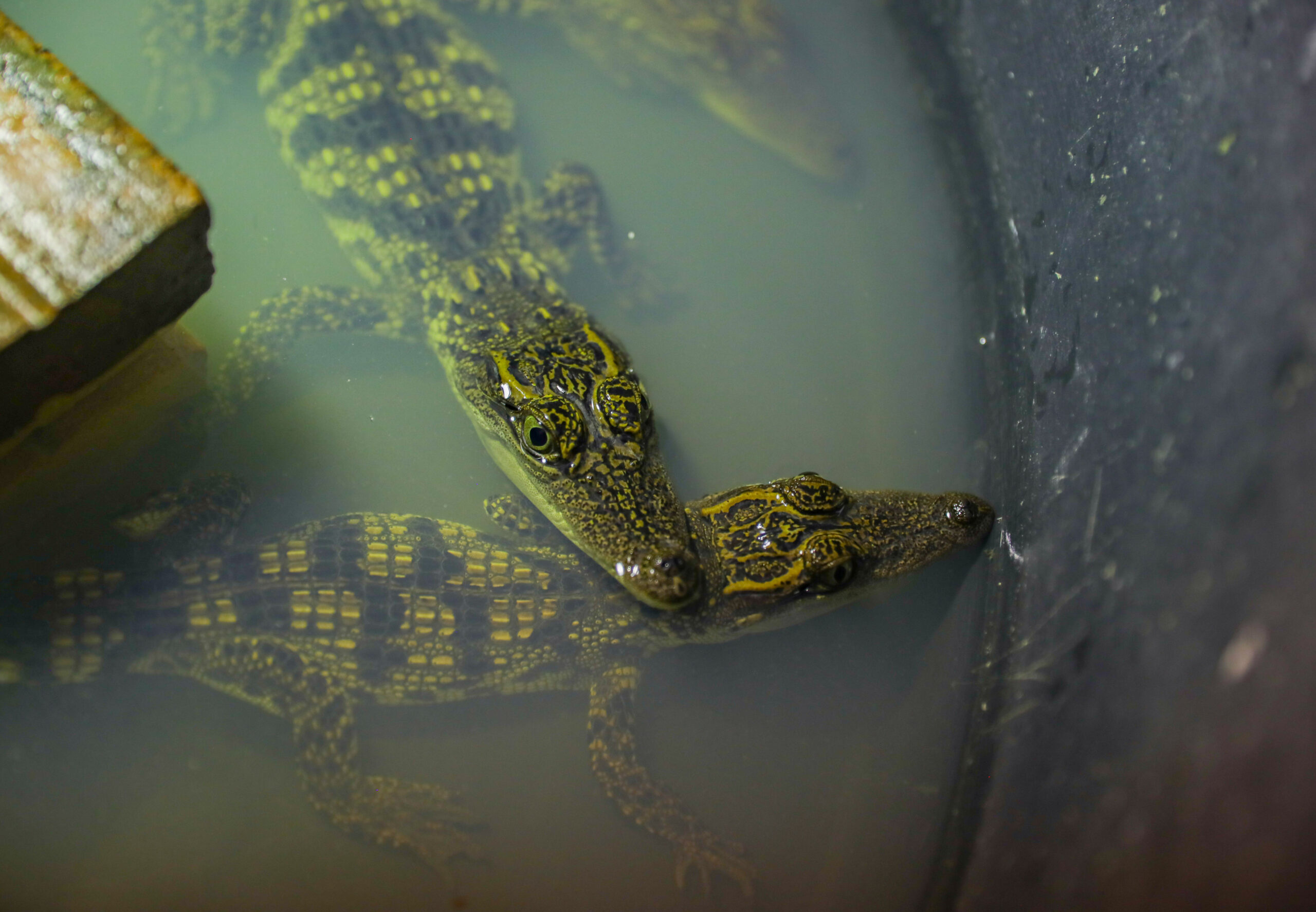
An international market for Siamese crocodile products, from skins and skulls to leather products and live individuals, is recorded on the CITES trade database.
From 2010 to 2020, Cambodia, Thailand and Vietnam reported the export of more than 547,000 live Siamese crocodiles, with China listed as the importer of nearly 80% of these crocodiles. All were recorded to have been bred in captivity.
Over the same period, the three countries reported the export of almost 400,000 skins and more than 80,000 ‘bodies’ to countries across the world. The biggest exports recorded involved more than 100,000 live Siamese crocodiles sent from Vietnam to China in 2019, and 78,040 bodies exported from Thailand to Hong Kong in 2013.
A 2021 study on the world trade in crocodilian skins found the total number of skins traded globally has declined since 2013 but nearly four million skins were traded from 2017 to 2019. An average of 42,800 Siamese crocodile skins were traded annually from 2010 to 2019.
While the skins market was declining in the lead up to the pandemic, demand for Siamese crocodiles was holding steady for a different use – meat.
“Live animal trade involves relatively few individuals except for the Far Eastern trade in Siamese crocodiles,” the report stated. “These animals are bred in captivity in Cambodia, Thailand and Vietnam, and until 2019 were exported in large numbers to China where they are consumed as food.”
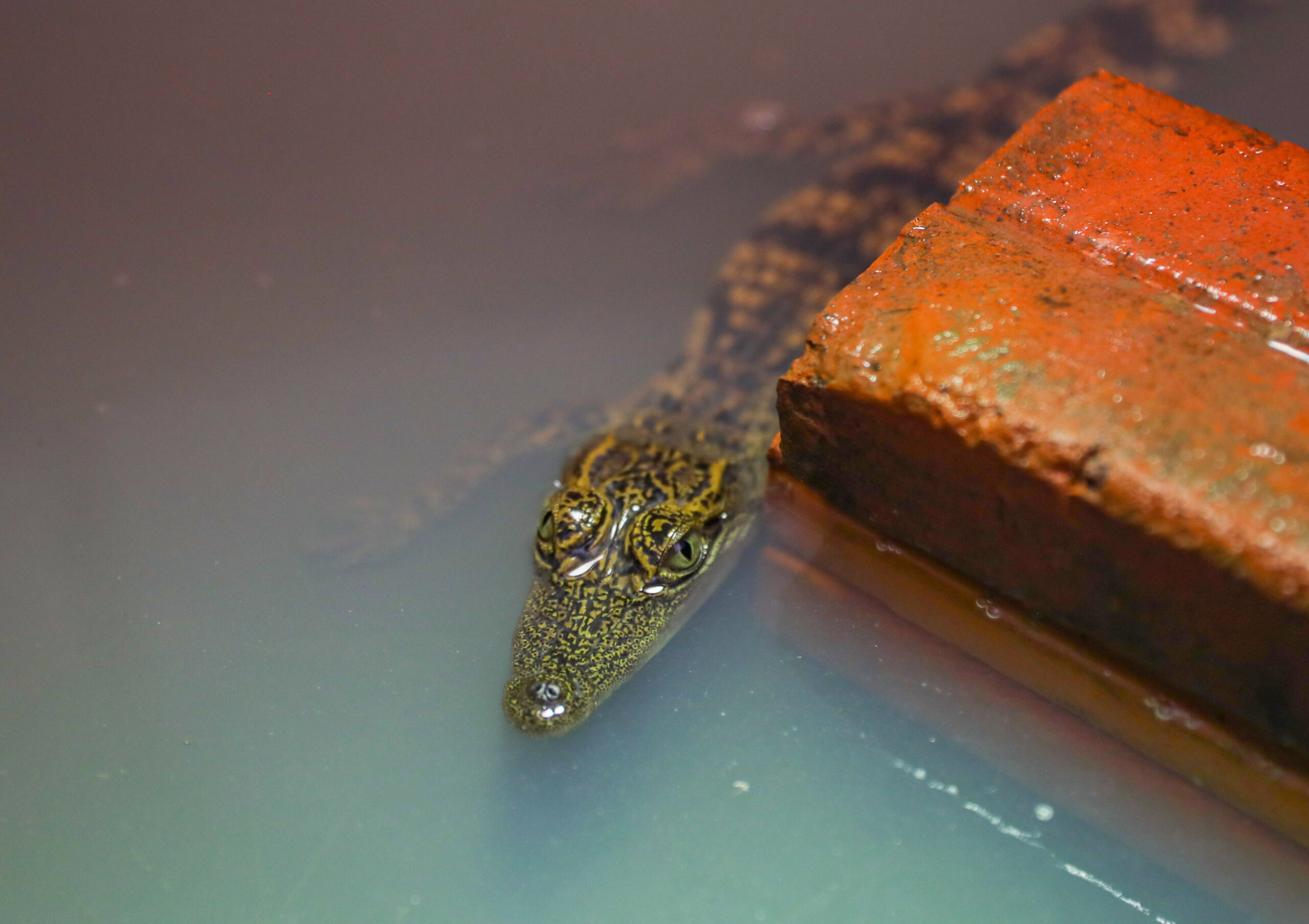
The 2000 rediscovery of Siamese crocodiles in the Cardamom, or Krâvanh in the Khmer-language, Mountains led to the establishment of the Cambodian Crocodile Conservation Project, a collaboration between Fauna & Flora and the Cambodian government.
Given the critically low numbers in the wild, the project established a captive breeding programme with 35 Siamese crocodiles tested to be pure-breds in the hybrid enclosure of Phnom Tamao Wildlife Rescue Center in 2009.
Several years later, in 2012, the project launched a release programme, which has since reinforced the existing population in the Cardamoms with 136 crocodiles, according to Pablo Sinovas, Fauna & Flora flagship species manager.
As part of the programme, conservationists have turned to commercial farms, the source of by far the biggest populations of Siamese crocodiles alive today.
“There is an opportunity for the stock that is available in farms to contribute to the recovery of the species in the wild,” Sinovas said. “We are trying to leverage the genetic pool in the stock available from the farms to help strengthen wild populations.”
A third of the Siamese crocodiles released to date were from farms, according to Sinovas. In total, he said approximately 300 crocodiles have been donated by farmers to the conservation project.
“Farm donations are really important to conservation because Siamese crocodiles have gotten to such small stocks,” Rose said. “It would take a very long time for it to breed and build its own population up. Releasing additional crocodiles helps diversify the gene pool and boosts numbers in those remaining wild stocks.”
Jenny Daltry, a technical advisor for Fauna & Flora in Cambodia who was part of the survey team that rediscovered the Kingdom’s wild Siamese crocodiles, said that initially farms were the biggest threat to the region’s crocodiles: “So many farms, in Cambodia and in the region, were just sucking animals out of the wild.”
“It was quite difficult to partner with the industry at that stage when they were just taking animals out of the wild,” Daltry said. But while developing a relationship with the industry has proven challenging at times, it is now “going in the right direction.”
While “opportunistic, small-scale poaching might occur,” farms likely no longer systematically take from the wild, according to Sinovas. “Given the very small numbers of Siamese crocodiles in remote wild locations, it would not be worth the effort to seek them out [when] thousands are breeding in farms,” he said.
Siamese crocodile conservation exists alongside crocodile farming industries in Cambodia, Thailand and Vietnam. Among the nearly 50 CITES-registered captive-breeding operations in the three countries, the most recent farm was registered in Thailand in March 2021.
The Thai Crocodile Farmer Association, in association with the Department of National Parks, Wildlife and Plant Conservation and Mahidol University, released 20 pure-bred Siamese crocodiles in 2020, according to Yosapong Temsiripong, chairman of the association, which represents 20 CITES-registered farms.
“We help wild populations by releasing crocodiles every year. Not only to rebuild wild stocks, but also to rebuild our reputation and change the perception of crocodile farmers in Thailand and Southeast Asia,” said Temsiripong, who is managing director of Sriracha Moda, a farm with more than 20,000 crocodiles.
“And the only reason we release so few, or so relatively few, is because we have no habitat left. All we have to work with is Pang Sida National Park,” said Temsiripong, who explained the association’s plan to release the same number of juvenile Siamese crocodiles into the national park every year starting in 2023.
Siamese crocodile conservation programmes operate in Laos, but studies and reports have found no evidence of a commercial crocodile farming industry in the country. Research papers, however, claim that some of Laos’ crocodiles were taken to stock farms in neighbouring nations.
Steven Platt, a herpetologist with the Wildlife Conservation Society managing a crocodile conservation project in Savannakhet, Laos, said 112 pure-bred Siamese crocodiles have been released into the Xe Champhone wetlands.
“I don’t have anything against farming, per say, but there are no conservation benefits to farming,” said Platt, who has worked on crocodile conservation in Southeast Asia since 1999. “When you have states that don’t have very good governance or monitoring mechanisms in place, those farms work to the detriment of wild populations of crocodiles.”
Whether commercial farming and trade of endangered species can help wild populations is a hotly debated topic among conservationists.
Advocates for a ‘sustainable use’ model of conservation contend a legal trade of farmed wildlife products can satisfy demand, thereby reducing pressure on wild populations. Other conservationists argue that legal trade often increases the demand for wildlife products, and the strict regulation needed to ensure wild populations are not negatively affected is difficult to achieve in practice.
In a 2016 study, Laura Tensen, a postdoctoral researcher at the University of Koblenz-Landau, proposed conditions that have to be met for farming to benefit conservation, including farming not increasing customer demand, customers showing no preference between wild or farmed products, operations remaining cheaper than capturing wild animals and farms not restocking from the wild.
“The minute any of these criteria aren’t met, there will be a negative effect on wildlife populations,” said Tensen, adding that situations which meet all the criteria are “very, very rare.” Significant enforcement and monitoring is needed to ensure criteria standards and without this, “wildlife farming can have disastrous effects.”
There are several examples of wild populations plummeting after the launch of commercial farming, from tigers in Laos to giant salamanders in China.
Patrick Aust, a member of the IUCN Crocodile Specialist Group, argues that the problem with the region’s crocodile farming industry is the way it was developed, rather than the concept.
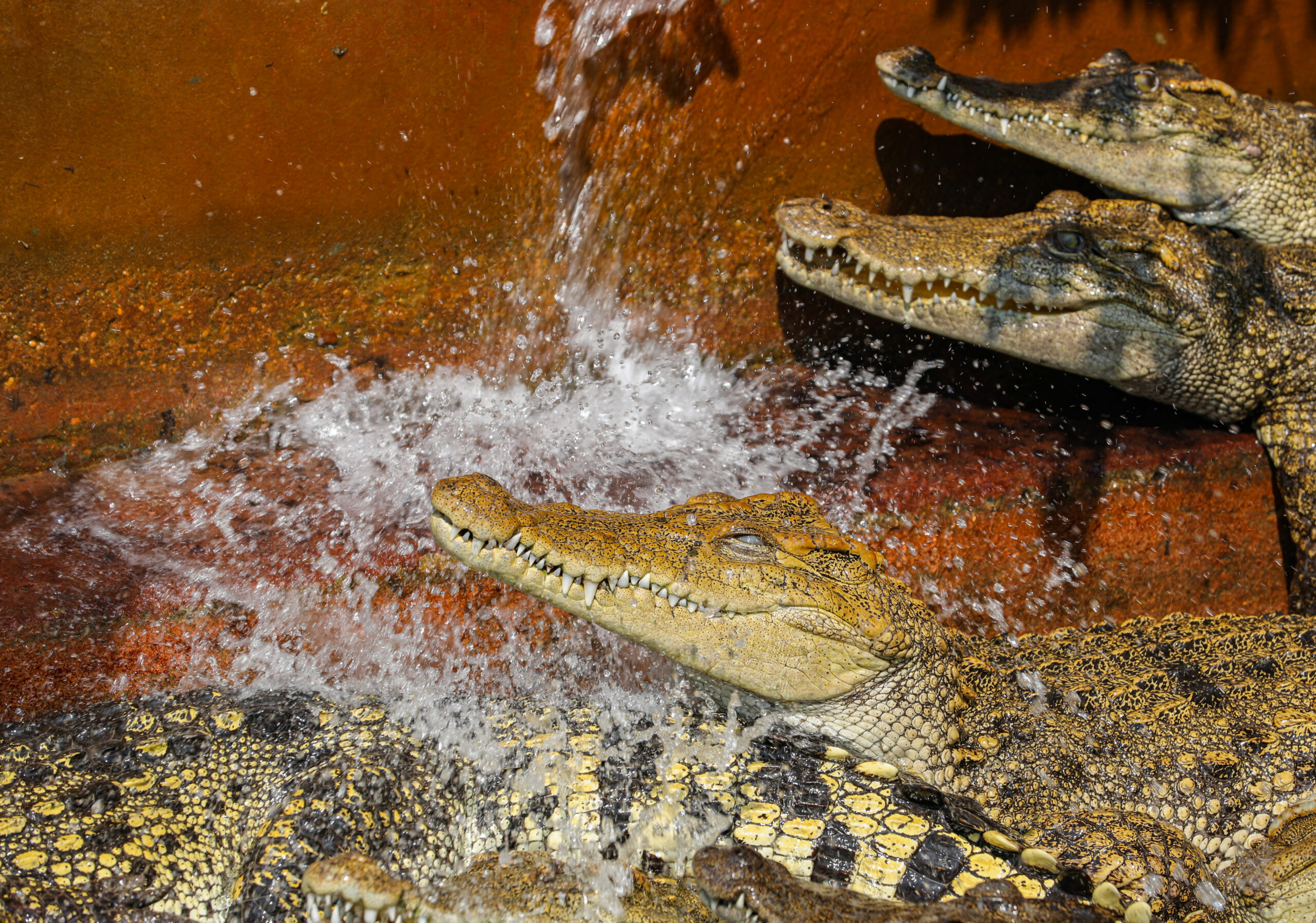
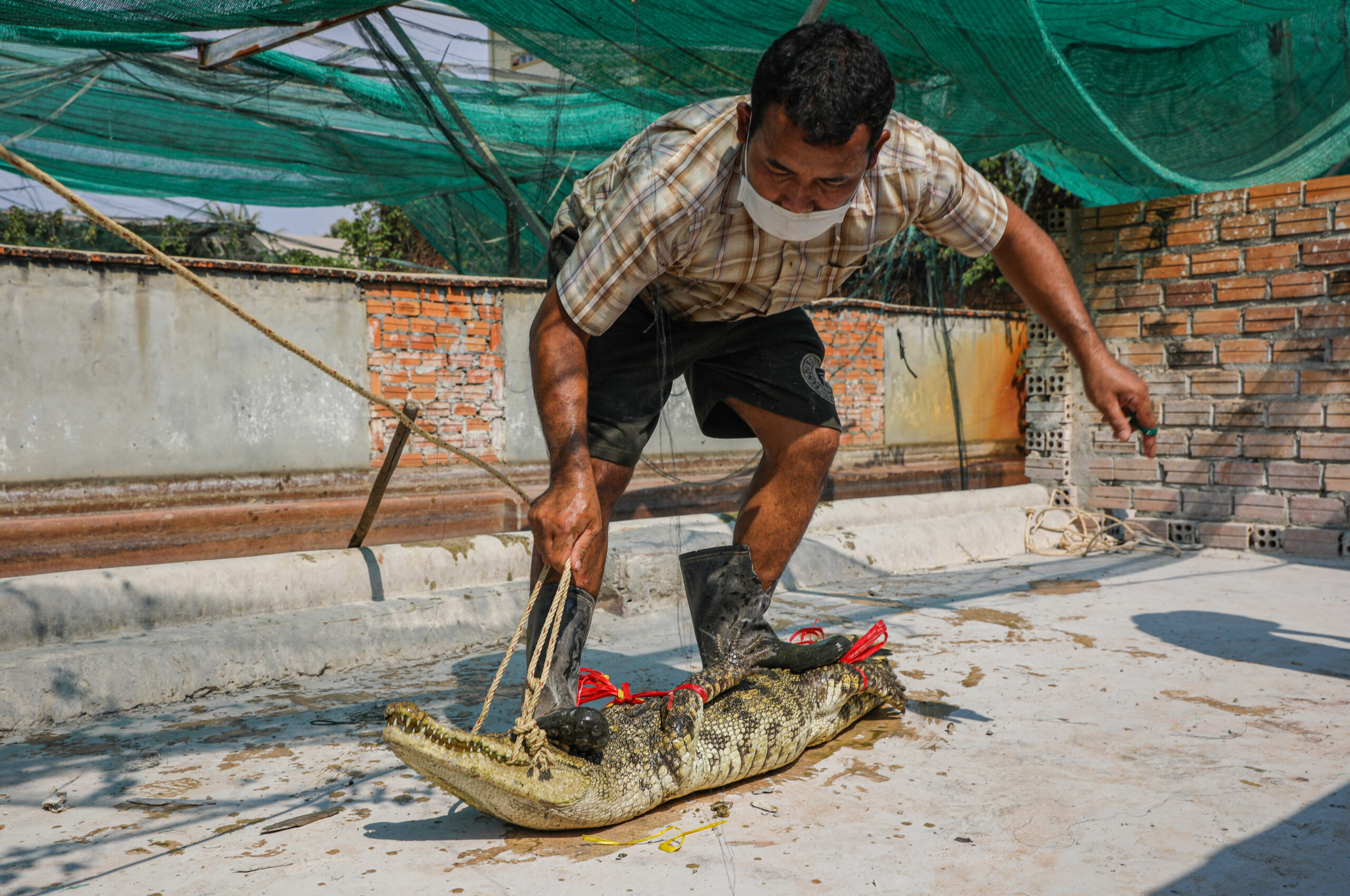
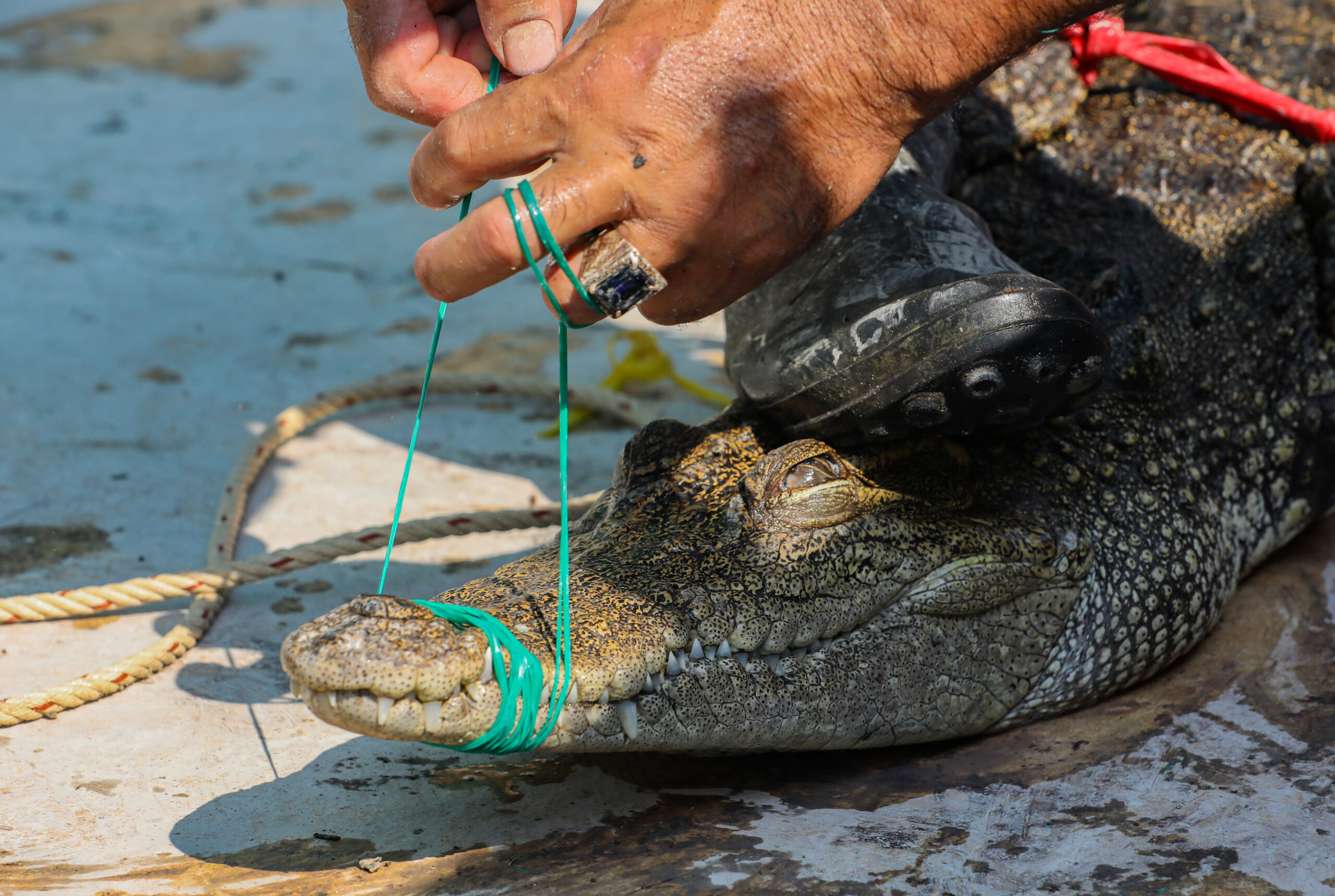
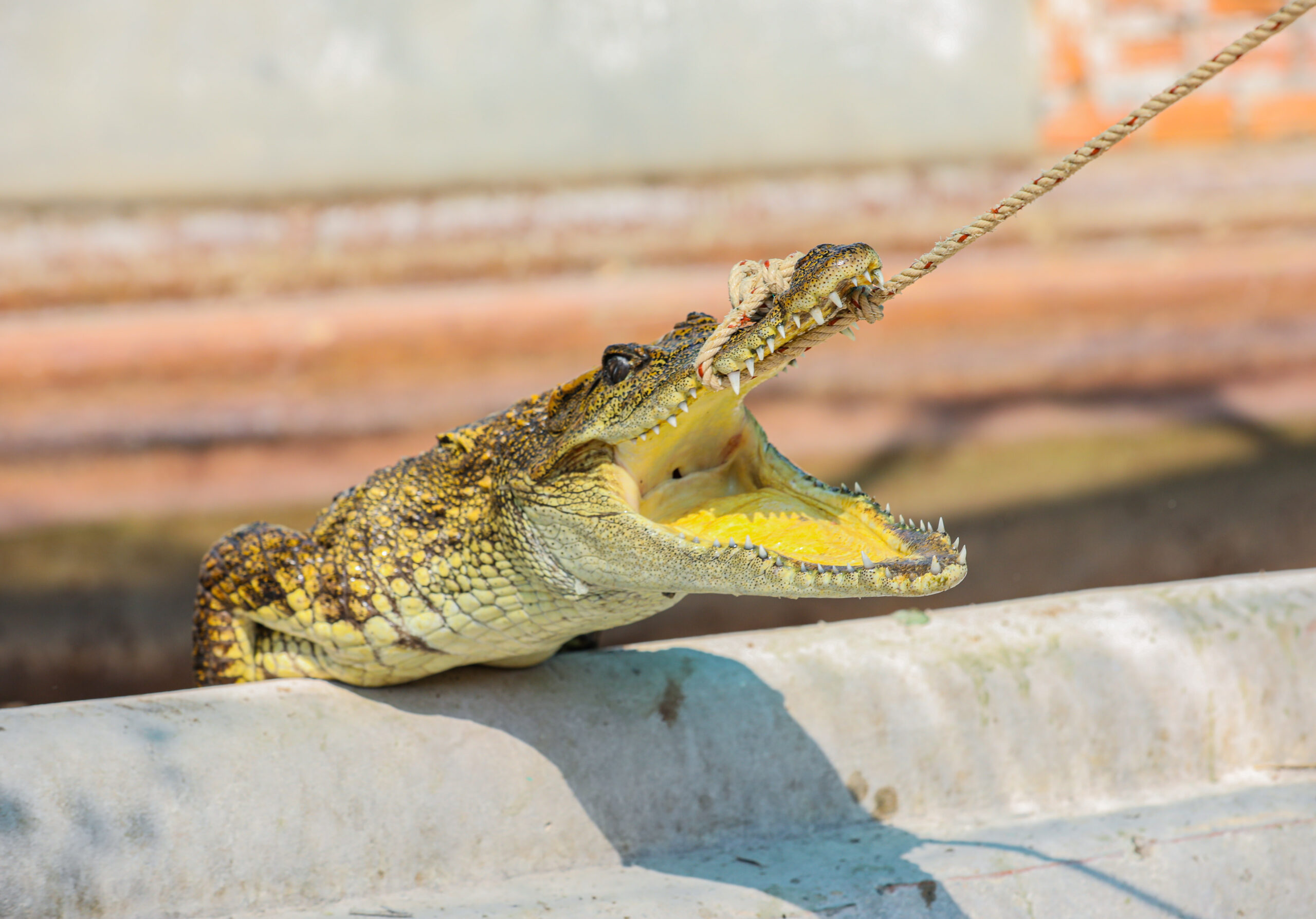
Wranglers capture more than 20 crocodiles from a crocodile farm in Siem Reap as part of a donation from the farmer to conservation groups in the Kingdom trying to save Cambodia’s last wild populations of Siamese crocodiles.
“There wasn’t any forward-thinking research or multidisciplinary environmental, social development work accompanying the expansion of the industry,” Aust said. “It was driven by the almighty dollar and the almighty dollar alone.”
According to Aust, who studies the agricultural potential of reptiles at the University of Oxford, small-scale crocodile farms were “beautiful little models” that could overcome issues such as extreme weather and disease outbreaks that impact other farmed species: “They are a very versatile agricultural species to add to agrifood systems in a small-scale context, in fragile small communities.”
“People need to celebrate the linkage between crocodile farming and climate change” and “understand the value crocodiles give vulnerable communities that live in volatile environments,” he said.
“The problem was the production model got centralised into bigger and bigger farms, detracting from that small-scale, resilient, sustainable model,” Aust said. But he believes “an optimal model of sustainable use conservation has already been proven to work” – crocodile ranching in Australia.
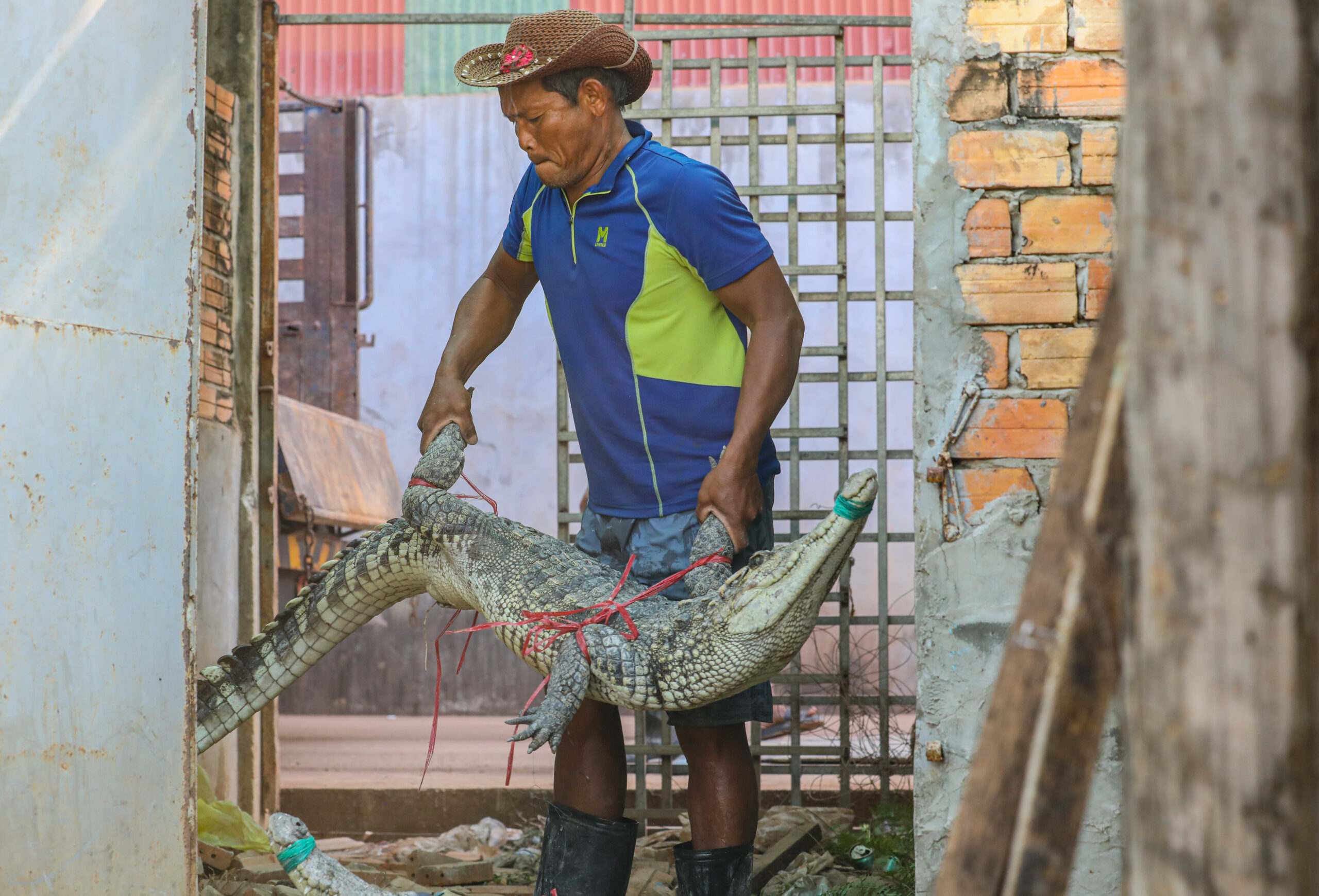
“Regulated and sustainable trade works. Sustainable use works,” said Inger Andersen, executive director of the UN Environment Programme, during her opening remarks at the 2019 CITES summit. Andersen’s first and only example was Australia’s crocodile trade.
A 2019 CITES case study on saltwater crocodiles in Australia’s Northern Territory found over-hunting from the 1940s to 1960s caused severe declines in the wild and a “sustainable use” programme afterward contributed to wild population recovery. The programme is frequently referenced as a case study of successful sustainable use in broader debates on commercial exploitation of wild animals.
The main model used in Australia’s crocodile industry is ‘ranching,’ which relies on collection of wild eggs or young crocodiles, which are statistically unlikely to survive to adulthood, and rearing them in captivity. They are then killed and processed when they reach a commercially viable size. The model is meant to incentivise landowners to protect crocodile habitats, as the model depends on wild populations.
Charlie Manolis, interim co-chair of the IUCN Crocodile Specialist Group, recognises the success of Australia’s sustainable use programme, but believes its applicability in other contexts and countries has limitations.
“This style of conservation doesn’t work for everyone or every species, but for crocodilians in Australia it has worked,” said Manolis, who is also chief scientist at Wildlife Management International, a sustainable use conservation company. “In some countries, there is a limit to what you can do because of nature and demographics.”
A key factor for Australia’s success was the vast potential habitat in the Northern Territory, which Manolis said many countries in Southeast Asia have lost: “In other countries, like Thailand, there is so little habitat left. Where are you going to put your Siamese crocodiles?”
In contrast to Australia’s ranching model, crocodile farms in Southeast Asia use a ‘closed-cycle’ system, in which crocodiles of all ages were captured from the wild to create captive-bred populations. Adult crocodiles are bred in captivity to produce eggs, which are reared until juvenile crocodiles grow to a commercial size and are sold or slaughtered. In this system, the only interaction with wild populations is when the animals are taken to supply farms.
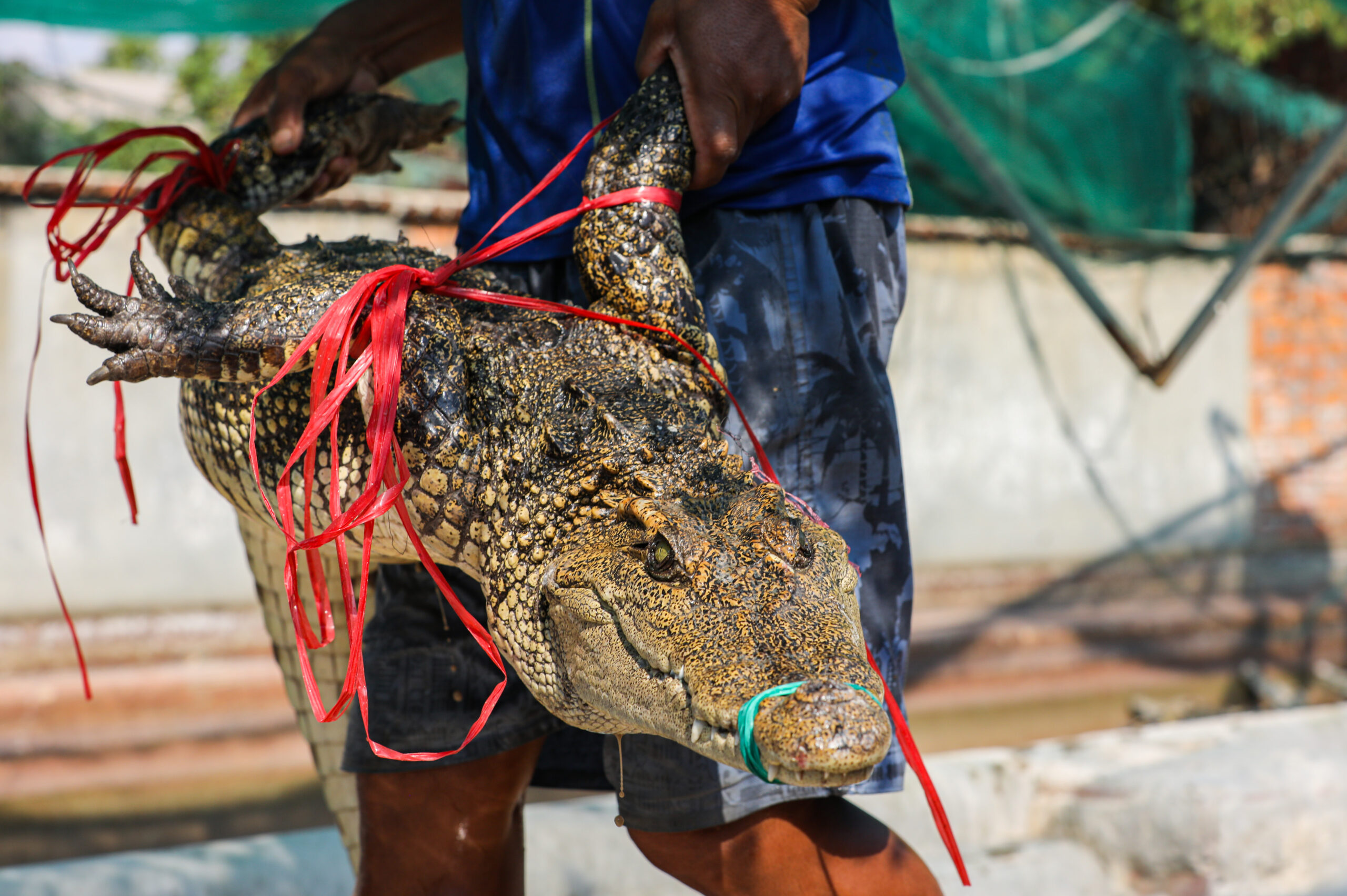
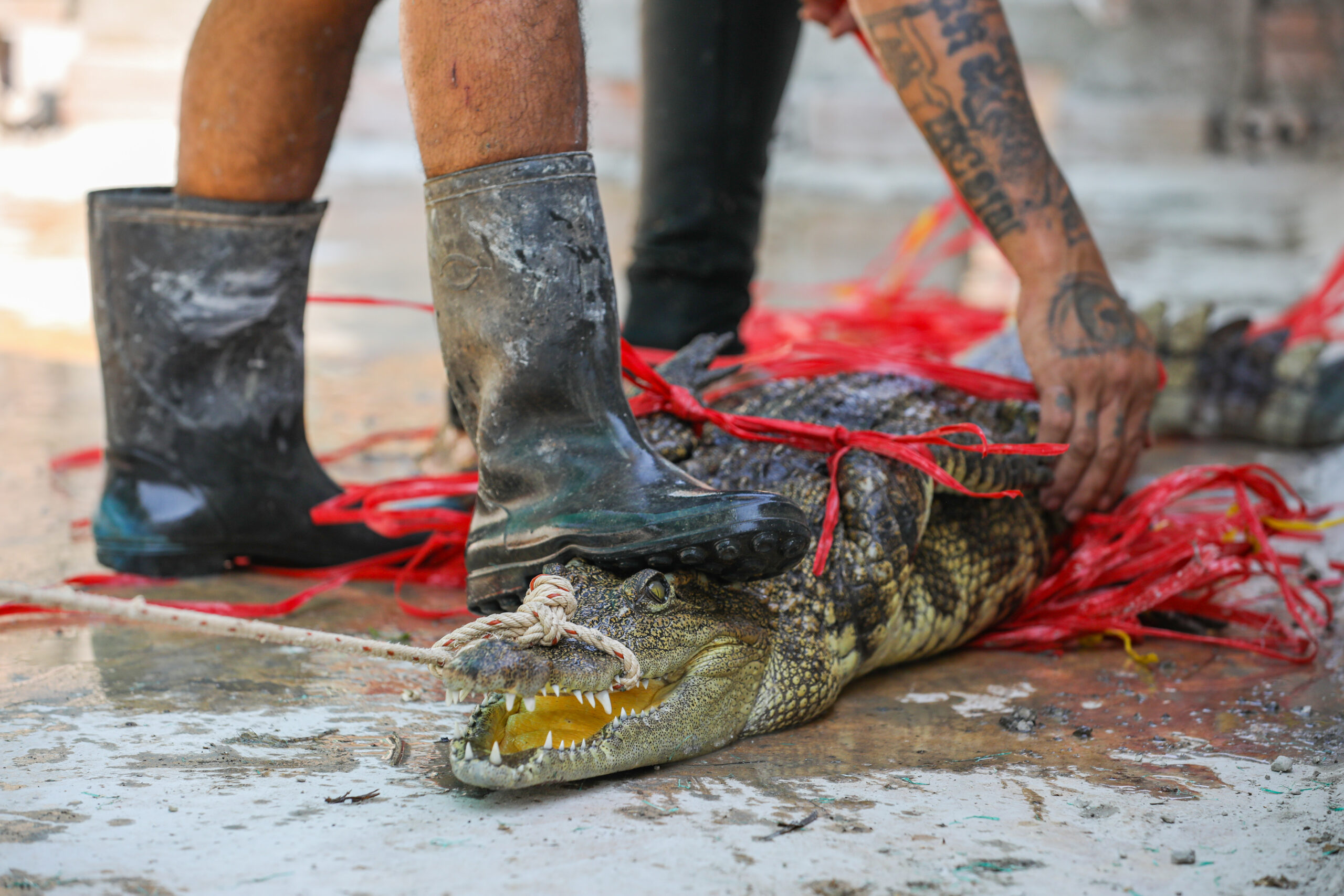
The relationship formed between landowners, ranchers and conservationists was another key aspect of Australia’s success, Manolis said. However, he warned that given the tiny numbers of Siamese crocodiles surviving in the wild, declines in suitable habitat, and limited infrastructure for government regulation, replicating Australia’s crocodile ranching success in countries like Cambodia is unlikely.
Daltry agreed that attempting to implement ranching as an alternative to Southeast Asia’s farming model would be risky. Since “so many livelihoods depend on the industry,” she said, it would “be very hard to put the toothpaste back in the tube.”
“Crocodiles are in more restricted areas, and with the aid of Indigenous people and local authorities, those populations can be protected and monitored more effectively,” Daltry said. “It is probably safer to stick with farming than try to set up anything too complicated that would need a lot of regulation.”
Despite the crocodile farming industry’s historic role in the demise of Southeast Asia’s wild crocodiles, Daltry said conservationists need to work with farmers because she believes that as long as there is international demand for crocodile products, the industry will remain a fixture in the region’s wildlife trade.
“I am not saying you should stop the farming industry or close it down. It is there, it exists,” she said. “What we need to look at is how do we work with the industry to ensure some of these animals live in the wild.”
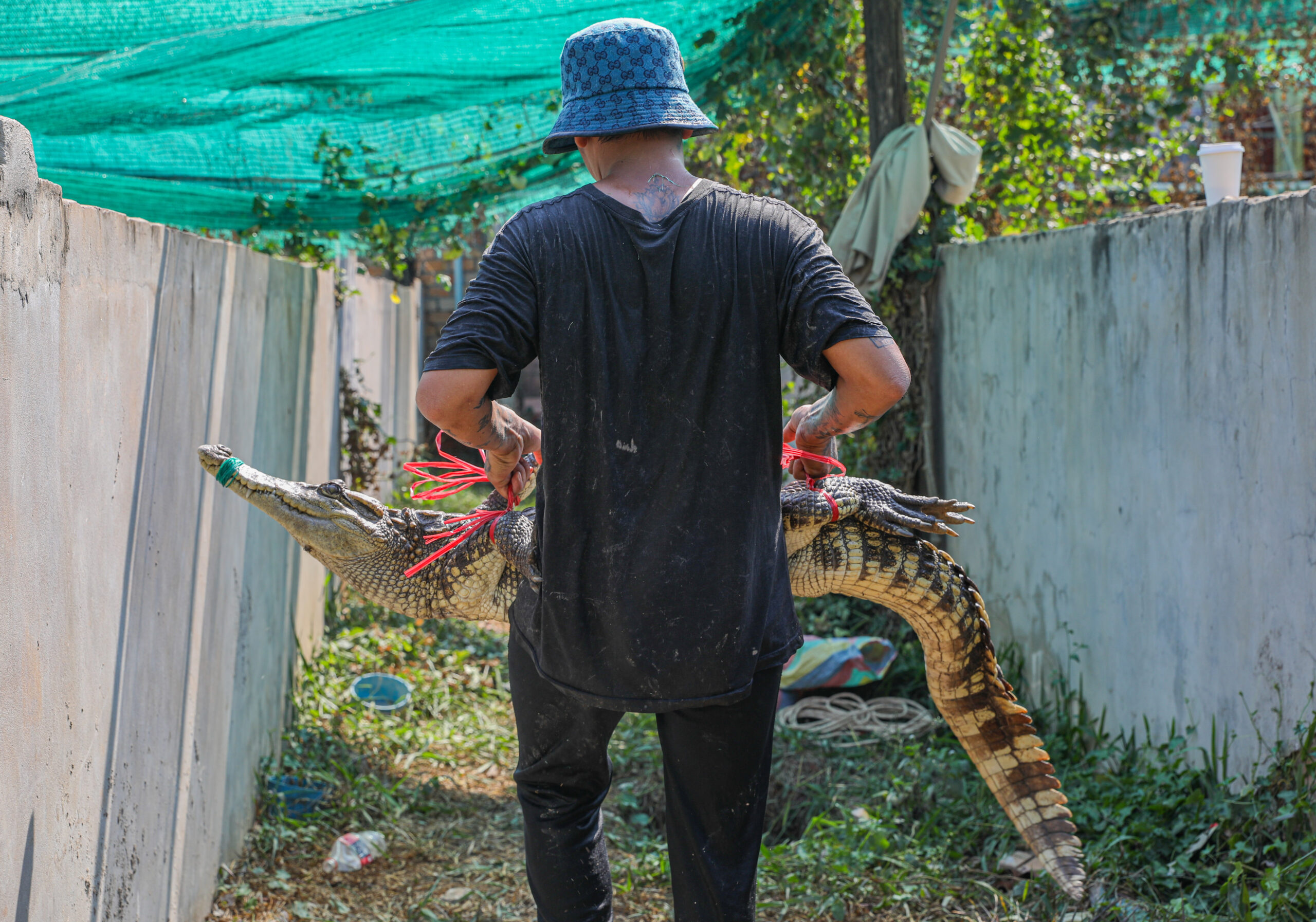
Sinovas steadied himself on the riverbank as he draped the belly of a Siamese crocodile over his leg, clenched its jaw shut with his left hand and supported its neck with his right.
He held his breath before launching the 183-centimetre (72-inch), 25-kilogram (55-pound) Siamese crocodile into Steung Kampong Tachey, a part of the Sre Ambel River that flows through Southern Cardamom National Park.
The snarl of the crocodile could be heard over the rushing rapids until it was silenced by submersion.
This crocodile was part of Fauna & Flora’s largest-ever crocodile release in Cambodia that took place in March. The group released 25 pure-bred Siamese crocodiles into the Cardamoms to reinforce the existing population. All of the animals were farmer-donated.
“From farm to forest,” Sinovas said. “The lucky ones.”
Photos by Anton L. Delgado for Southeast Asia Globe. This story was produced in collaboration with The Third Pole.
